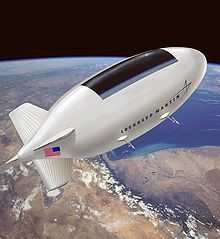High-altitude airship

The United States Department of Defense Missile Defense Agency contracted Lockheed Martin to construct a high-altitude airship (HAA) to enhance its Ballistic Missile Defense System (BMDS).
An unmanned lighter-than-air vehicle, the HAA, is intended to operate above the jet stream in a quasi-geostationary position to deliver persistent station keeping as a surveillance platform, telecommunications relay, or a weather observer. They proposed to launch their HAA in 2008.
The airship would be in the air for up to one month at a time and was intended to survey a 600-mile (970 km) diameter of land. It will use solar cells to provide its power and would be unmanned during its flight.
It is designed to be 500 feet (150 m) long and 150 feet (46 m) in diameter. To minimize weight it is to be composed of high strength fabrics and use lightweight propulsion technologies.
The HAA is intended to operate at a height of above 60,000 feet (18,000 m) and to have a payload for military use.
Lockheed Martin and the U.S. Army launched the HALE-D sub-scale demonstrator on July 27, 2011, demonstrating key technologies critical to the development of unmanned airships. The airship was supposed to reach an altitude of 60,000 feet, but a problem occurred at 32,000 feet. It descended and landed without damage and no one was hurt.[1]
High altitude airships can improve the military’s ability to communicate in remote areas such as those in Afghanistan, where mountainous terrain frequently interferes with communications signals.[2]
See also
- Integrated Sensor is Structure
- Long Endurance Multi-intelligence Vehicle
- TCOM Blue Devil
- Stratospheric airship
- High-altitude platform
- Orbital airship
- 21st Century Airships
References
- ↑ "HALE-D flight aborted". Lighter-Than-Air Society. July 27, 2011.
- ↑ "High Altitude Airship". Lockheed Martin. 2012-03-06. Retrieved 2012-08-15.
External links
- HAA page at Raven Aerostar
- HAA page at Lockheed Martin
- HAA page at Global Security
- HAA contract info